Media | Articles
Can-Am’s New Maverick R and a New Paradigm of Driving Joy
This article first appeared in the May/June issue of Hagerty Drivers Club magazine. Join the club to receive our award-winning magazine, and as part of the first-ever HDC Days from June 21 to June 23, Hagerty Drivers Club members will be eligible for some amazing deals, cool contests, and epic events and experiences. Not an HDC member? Sign up today!
The trails spiderweb their way across the Sonoran desert, apexes marked by creosote, sage, and whim. A tangle of two tracks over sand and dry riverbed sprawl out to the jagged ridges on our horizon, and the Can-Am Maverick R is hungry for it all. Its wastegate chatters at the low, gray sky as I lift the throttle to get the machine to pivot before piling on the fuel, the turbocharged triple shoving 240 horsepower at all four wheels, the seven-speed dual-clutch gearbox clicking off shifts with all the speed and precision of a Porsche PDK. In half a second, the big Maverick has painted the world black and white, obstacle and line. It has shoved everything else from my skull. Every nagging worry and thin plan banished with narcotic clarity. It’s as good as driving gets.
It’s a long way from where I was four years ago. I have the dubious distinction of having left my dream job as an editor with Road & Track not once, but twice. First, to pursue a year on the road with my wife and 1-year-old daughter. And a second time for reasons I couldn’t voice in the moment. In the nearly 20 years I’d spent as an automotive writer, I’d watched the sports cars I loved the most devolve into some bleary shadow of themselves. Heavy. Complicated. Overpowered. Increasingly interested in subtracting the driver from the equation in pursuit of ever loftier speeds and shorter 0–60-mph times.
I found myself driving machines that were technically excellent in every way—fast, safe, efficient—and somehow terminally boring.
The great democratization of speed had yielded a generation of performance vehicles capable of genuinely incredible things regardless of who was behind the wheel. If you had a pulse and were capable of putting the throttle on the floor, the vehicle would sort out the pesky details. It felt less like a partnership between driver and car and more like bowling with the bumpers on.
Marketplace
Buy and sell classics with confidence
On some level, it’s why so many of us are attracted to the cars that fill this website. Anyone with a set of pony car keys in their pocket knows that a modern Camry is a technically better machine. It’s faster in any contest of speed, vastly more comfortable, and safer by miles. And efficiency? Well, why kick a man when he’s down? But those of us who love cars and driving them aren’t here for the spreadsheet. We don’t spend our waning waking moments chasing off-idle stumbles or up to our elbows in the innards of a small-block in pursuit of some bleeding edge. We’re there because there is no algorithm for heart. Because ones and zeros may be better for conveying information, but they lack the fidelity necessary to craft Cormac McCarthy’s All the Pretty Horses.
So when Mark Hoyer, Cycle World magazine’s editor-in-chief, called and asked if I wanted to try helming UTV Driver, I left Porsches and Ferraris behind for what seemed like glorified golf carts. It felt like insanity. No one could even agree on what to call these things. UTVs? Side-by-sides? Razors? Gators? The nomenclature was a mess, but one thing was clear: These machines were scratching an itch that no production car or truck could. While the new performance car market withered year after year, side-by-sides were growing at an exponential rate. In 2009, manufacturers sold a little more than 225,000 units. In 2016, it was 444,000. In 2023, it was 680,000. Next year, Kawasaki expects its side-by-side business to outstrip its motorcycle sales.
That explains why the things are suddenly everywhere, bolstered by the states and municipalities that have embraced them. In addition to being road-legal in some places, side-by-sides have helped fuel an explosion of riding areas hand-in-hand with groups like Tread Lightly. New parks pop up every month in every corner of the country, most helping to rehabilitate land used for logging or mining. West Virginia enjoys one of the largest trail networks, with more than 900 miles of off-roading, and neighboring Kentucky is currently working to more than double that system using land that was once strip-mined for coal. For the first time in my writing career, I’d be covering a growing industry.

There are parallels between the automotive space and side-by-sides. Japanese manufacturers like Kawasaki, Yamaha, and Honda produce excellent—but conservative—machines, while North American–based Can-Am and Polaris are fighting with the gloves off. Polaris is the biggest player by a wide margin, but rival Can-Am has no problem matching the company blow for blow, building increasingly capable machines. And, as in the automotive sphere, workaday utility machines make up the vast majority of sales, funding the development of headline-snatching performance rigs like this Maverick R.
But these aren’t automotive analogs. You can spend $20,000 on a machine that doesn’t come with a roof. Windshields are universally optional, and functional HVAC is still a novelty. A day behind the wheel is usually hot, or cold, or wet, or dusty. Or maybe all four. Last year, we tested our first machine with power brakes. Mismatched panels, loose hardware, and other faults are common, even on zero-mile machines. You will not find a side-by-side with traction control or stability control, but you will find an industry that’s evolving at a blinding pace.
In my short stint as editor-in-chief at UTV Driver, the machines we test on a daily basis have leaped in refinement, fit and finish, power, and capability. Four years ago, adaptive suspension was all but unheard of. Now every major player offers some version of the system. Back then, there was no such thing as a side-by-side with more than 200 horsepower. Now there are two, and a third is on the way. Even the relatively pedestrian utility market has seen a sea change with the introduction of machines like the Polaris Ranger XP Kinetic, an EV with 80 miles of range and 110 horsepower, and the Ranger XD 1500, which is a true three-quarter-ton side-by-side complete with power dump bed. The sports car industry in the ’50s must have felt like this. Every day a revolution.
***
The Maverick R is the current tip of the spear, and Can-Am’s engineers went for blood. The machine makes 240 horsepower from a single liter, giving it better power density than hypercars like the Ferrari SF90 Stradale or McLaren Elva. And where most performance side-by-sides are stuck with miserable rubber-belt CVTs, Rotax designed a seven-speed dual-clutch gearbox for the mighty Maverick. DCTs are nothing new to side-by-sides. Honda broke that ground years ago when it dropped the engine and dual-clutch transmission from its Africa Twin motorcycle into the Talon, but that vehicle’s driveline feels like a beta test compared with the Can-Am. The Honda’s shifts are violent, the logic crude and underfoot.
And why wouldn’t it be? Writing code that accounts for all the variables that could possibly determine a gear change is hard enough for road cars, where the surface is largely smooth and predictable. But side-by-sides aren’t bound by groomed roads. Three-foot-tall vertical rock steps, deep sand, boulder fields, headlight-deep mud, and flat-out hardpack are all within their purview. Coming up with something that can account for everything an owner might throw at their Maverick R would seem all but impossible, but Can-Am and Rotax figured it out. At low speeds, the shifts are smooth, the throttle mapping intuitive. Crank up the wick and the gearbox snaps off shifts quicker than you can think. Like the PDK, you’re almost always better off leaving the machine to handle its shifts, though there are paddle shifters if you feel like meddling with things.
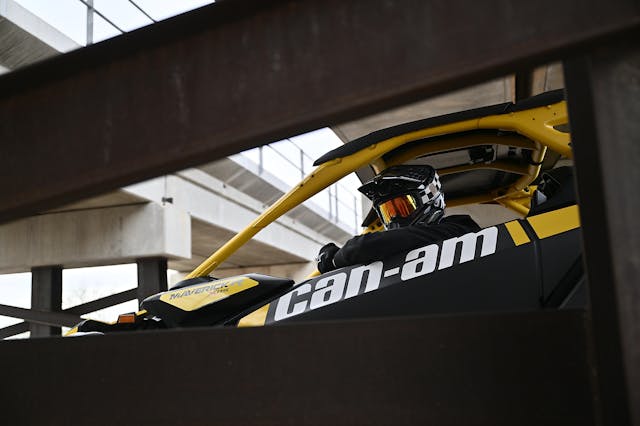
The astounding part is that the engine and transmission are minor slices of what sets the Maverick R apart from the rest of the side-by-side field. Can-Am pulled some wizardry with this rig’s suspension. Every other sport machine on the market relies on a double A-arm front suspension design. Lower-tier sport side-by-sides get along with rear A-arms as well, but most of the higher-end rigs make use of some sort of four-link trailing arm setup. Those options routinely deliver wheel travel that’s measured in feet, not inches, but they come with one notable drawback: a lofty center of gravity.
The Maverick R’s main rival, the Polaris RZR Pro R, is as tall as a Ford F-150, but it sits nearly 6 inches narrower. Combine those attributes with tall tires and a rear weight bias, and it’s no surprise how often side-by-sides flop over. To combat that problem, Can-Am did away with the front and rear A-arms, replacing them with what the company calls its “Tall Knuckle” design. Anyone who’s spent some time in the fenderwell of a ’70s Monte Carlo will recognize the concept. The upper ball joint sits directly above the wheel’s centerline, and Can-Am says that helps dramatically lower the vehicle’s roll center.
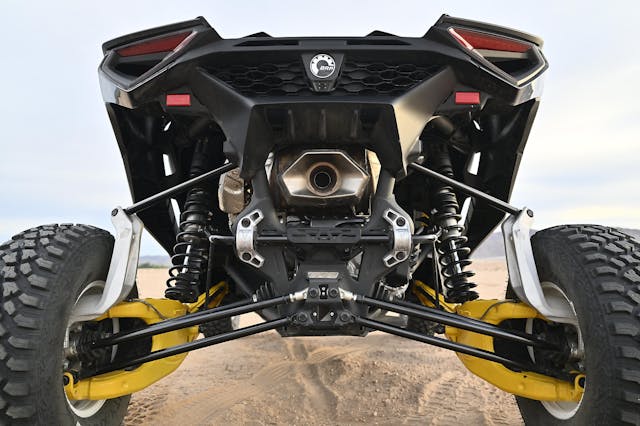
If you want the gritty details, then I encourage you to read Sam Smith’s excellent explainer on what that means for the Maverick R on UTV Driver. The short version is that the geometry of those wild, arching cast aluminum upper arms dramatically increases the vehicle’s stability. Sliding most side-by-sides is an exercise in flirting with the moment when the outside tires catch and you get a free ride in a tumble dryer. The Maverick R’s tolerance for that brand of hooliganism is orders of magnitude higher.
***
As the desert blurs past, my mind keeps hunting for an automotive analogy, something from my driving past that equates to this experience. The Maverick R has selectable four-wheel drive with a permanently locked rear differential and a driver-selectable locking front differential, though in certain driving modes, the machine can lock and unlock the front end for additional grip. In Sport mode, with four-wheel drive engaged, it feels like a Lamborghini Aventador SV or a Porsche 911 Turbo S. With the engine mounted behind your hips, the Maverick R wants to wag its tail here and there, but the four-wheel-drive system behaves more like a conventional all-wheel-drive system, and when you press the throttle to the firewall, the turbo spools and the front tires launch you in whatever direction you like.
Driving modes are old hat in both the automotive and side-by-side spaces, but they rarely do more than shove some shift points around. Maybe open up an exhaust baffle if you’re lucky. The same is true for the Maverick R’s Comfort, Normal, and Sport modes, but Sport Plus adds something truly bonkers: anti-lag. The system cuts the spark to one cylinder, turning the triple into a twin and using the dead pot to continuously pump air, keeping the turbo spooled. It sounds like a hot mess, but the instant throttle response will do uncouth things to your brain. I may not be Colin McRae, but it sure as hell sounds like I stole his Prodrive Subaru.
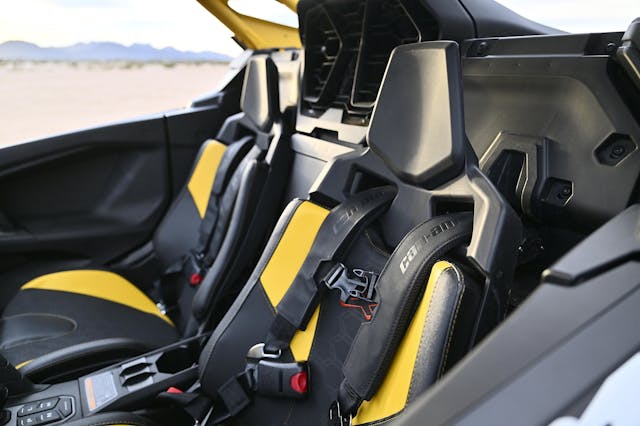
The crazy part is, even that legendary blue and yellow missile could not keep pace with the Mav R over this terrain. I know how that sounds. For one thing, we live in an age when 700 horsepower is nothing to write home about. When the electric sedan next to you in the pickup line may be quicker to 60 mph than anything Lamborghini currently builds. But this Can-Am weighs just 2240 pounds. That’s hefty by side-by-side standards, but that’s 100 pounds less than a 2024 Mazda Miata. We all know mass is the enemy of any type of performance driving, but that’s doubly true off-road, where every pound means your springs and shocks have to work that much harder to keep you from bounding into the bushes.
If you’re still bench-racing this thing in your head, maybe it will help to know this: Last year, Can-Am took the Maverick R to its first competition at the Silver State 300. Driver Dustin Jones took the overall win at the race, beating every motorcycle, every trophy truck, every other competitor. And he did it in an essentially stock Maverick R. Second and third? Yeah, those went to Mavericks, too.
That’s partly because this machine glosses over whatever is in front of it. Ground clearance is an insane 17 inches. A Bronco Raptor gets along with 13.1. The Can-Am serves up 25 inches of usable wheel travel up front and 26 inches in the rear. A Raptor R? Try 14 and 15, respectively. Those numbers mean you have to recalibrate your mind for what is and what is not a threat on the trail. Any stone smaller than a 2-liter bottle can go right under the machine and never touch the bottom. Whoops and rollers, ledges of all kinds—they all vanish under the Maverick R at speeds that would obliterate any other production vehicle.

I’ve spent four years putting friends from my former life behind the wheel of various side-by-sides. My first piece of advice? Take whatever mechanical sympathy you have and discard it. You won’t need it here. The machine can take more than you can possibly throw at it. And it’ll do it while taking you farther and farther from another human. Save for the odd holiday weekend, we don’t see another soul on most of our rides. When was the last time you could say the same for your favorite stretch of tarmac?
That fact carries its edges, though. This type of recreation requires a certain amount of self-reliance. Flat a tire or roll a machine in the middle of a 70,000-acre riding area miles from the nearest cell tower, and odds are you’re on your own.
For me, the fun outweighs the risks. The loose surface means that 240 horsepower is more than a mortal like me will ever fully take advantage of. I’ve long suspected that grip is driving joy’s true assassin, and machines like this prove it out. The hilarious part is that some automotive manufacturers are realizing that, too, building loose-surface versions of their roadgoing sports cars. Look no further than creations like the Porsche 911 Dakar and Lamborghini Huracán Sterrato. The only difference is that when I inevitably put the Maverick R on its roof, I’ll roll it over, laugh, and keep riding. Do that in your cosplay Porsche and it’s headed to the scrapheap.
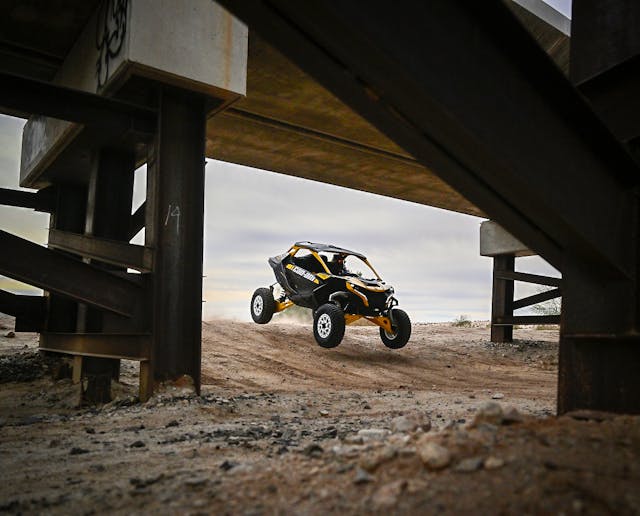
I bring the Maverick R to a stop after sprinting over a field of soccer ball–sized stones and let the machine idle a moment, the sourdough taste of adrenaline on the back of my tongue. When I reach up and cut the ignition, there’s nothing but the sound of cooling metal and the smell of a coming rainstorm. The desert’s alive with it, every plant open and perfumed, all having carved a niche from an impossible landscape. As special as this machine feels, Can-Am didn’t execute any miracles in its development, save one: Its engineers did not shy away from specialization.
We’ve somehow arrived at a place where we think every vehicle needs to be capable of daily driving, year-round, anywhere on the globe. But it’s madness to expect your Wrangler to handle commuting duty and deliver off-road excellence. Insanity to think you should be able to drive your 296 GTB through Calgary’s winter and lap the Nürburgring. We do not ask for that sort of universality from anything else in our lives, except maybe our home, and yet, here we are. That expectation leads to a staggering amount of weight, compromise, and cost—all things directly opposed to a good driving experience.
Maybe that’s at the root of it. The thing that drove me from Road & Track years ago. Because cars weren’t always that way. The last feature I worked on for the magazine was a wonder, and it put me behind the wheel of a genuine narrow-body 289 Cobra. For all its lore and glory, for as excellent as it is to slide behind the wheel and aim those leaping fenders at a twisted bit of two-lane, it’s a horrible car. The roof was optional, the doors performative. There was no air conditioning, and the dash was a literal board. And yet, that car holds our collective imagination because a group of people decided to make the best sports car possible at the time. It didn’t need to fit a child’s seat or hold your latte. It just needed to be brilliant. And it was.
It was also cheap. We forget that it wasn’t originally a million-dollar car. With inflation, the original owner of that 289 Cobra paid a little more than a base Accord costs today. Fitting, then, that this Maverick R rings in at $42,599. You’ll pay some more if you want the smart shocks, but unless you plan on giving Dustin Jones a run for his money at the next race, you’re probably fine with the external-reservoir Fox jobs on this X RS. On the surface, that seems like an astronomical amount of money for a pile of tube steel and aluminum, but trust me when I say you cannot have a fraction of this driving experience for triple the money, on-road or off.
The cars that we come back to time and again are like that Cobra. The longnose 911s and GT350s. The Z/28s and Dinos. Sure, you could drive them year-round, but it meant you were our kind of loon. The Maverick R shines in the same way. It is not for everyone. It has no interest in making you look like a hero or holding your hand. Your comfort will always come secondary to its performance. But it is an eager partner, and if you’re willing, it will open up the last frontier of pure driving, far from any road.
***
Check out the Hagerty Media homepage so you don’t miss a single story, or better yet, bookmark it. To get our best stories delivered right to your inbox, subscribe to our newsletters.









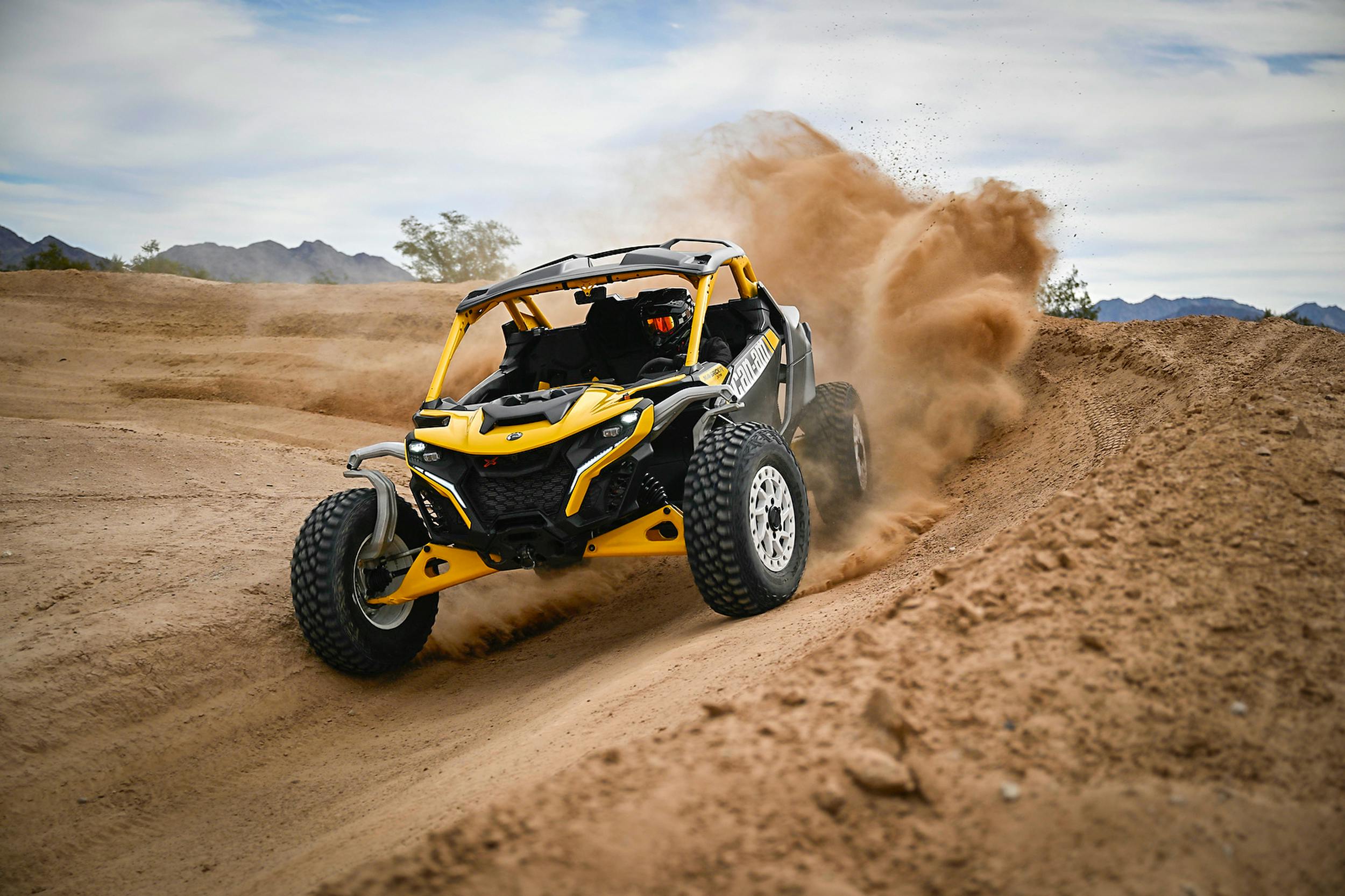
UTVs have quickly come to dominate, in terms of numbers, at the off-roading places I visit. Sometimes the drivers get impatient with our mere SUVs that, no matter how capable, require more time and patience to clear the obstacles. In much the same way as happened with street machines, it feels like the UTV wars are a race to the top–a point where the machine is far more powerful and capable than any mere untrained mortal should be piloting. This Can Am looks like it could provide maximum fun if the driver knows and obeys his limits. It would be great if one or more manufacturer created or sponsored a Bronco Off-Roadeo style training day for new owners, especially to teach “tread lightly,” “do not make new trails,” and “leave it better than you found it.” These are becoming significant issues that could cause us all to lose access to our trails.
Very well put sir.
This is one of the most well written articles I’ve read in a long time.
I recently visited the Coral Pink Sand dunes national Park in Utah, and paid for a UTV tour. I assumed I would be sitting in the passenger seat, but when I arrived they gave me the keys and said “game on!“. And so began one of the most enjoyable two hours of my adult life. You really don’t need to have any mechanical sympathy for the machines, they are built so tough. And they are a relatively safe and comfortable way to take the family members on true adventures.
Fantastic inventions, and have truly helped democratize the art of exploration…
A bunch of fun. If I had some land to off-road on I’d get something like this. Crazy to see the horsepower wars escalate in the off-roaders. Can 300hp too far off from the factory?
UTVs
Side by Sides.
Have no place on the streets.
As a former owner of a Maverick X3, I can attest to the fine workmanship of these vehicles. I will repeat what Clint once said, when driving these Monsters, “A man’s got to know his limitations”. Great article!!!
I ride ATVs side by sides and snowmobiles but people need to treed lightly and stay on marked trails. States are closing a lot of our trails.
Yes. Obey the laws. I’ve been a snowmobiler for a few decades. I’ve passed farm fields where the owner posted signs next to the trail stating winter wheat is planted and stay on trail Over the years there’s always some douche nugget that rides off the trail and around the sign. Seems every year a trail gets closed and then the local clubs struggle to find an alternate route. The land owners owe you nothing so show respect and obey the signs and laws